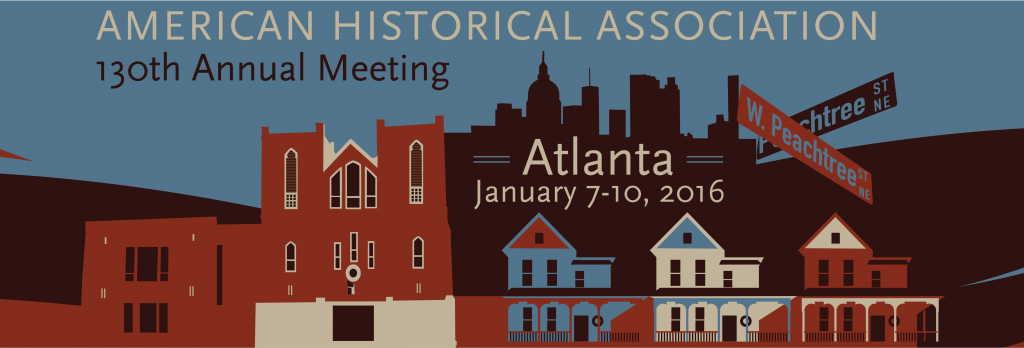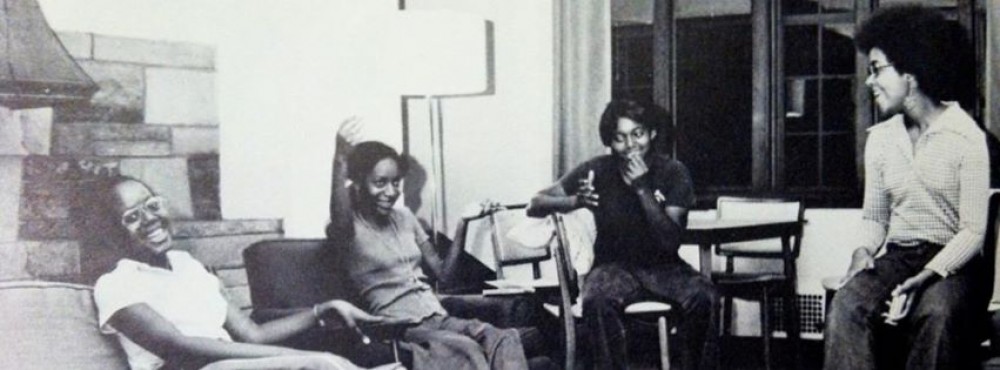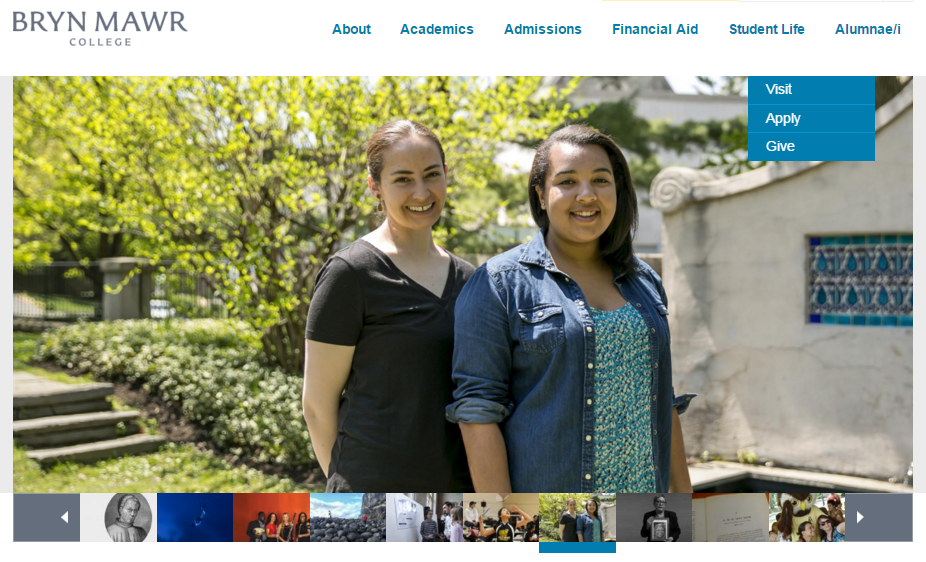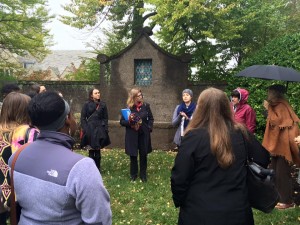The National Council on Public History (NCPH) has selected “Black at Bryn Mawr” as the honorable mention for its 2016 NCPH Student Project Award. Project advisor Monica Mercado accepted the award on behalf of Emma Kioko ’15 and Grace Pusey ’15 at the NCPH annual meeting on March 19, 2016. Read more on the Bryn Mawr College website.
Letter from M. Carey Thomas to Marion Park
Featured
by Grace Pusey
Emma and I commenced our research on Black history at Bryn Mawr with a file labeled “Park Students – Negro” in a box of papers pertaining to Marion Park’s presidency housed at Bryn Mawr College Special Collections in Canaday Library. Marion Park was President of the College from 1922-1942, and though her administration was not the first to handle the “question” of Black students’ admittance to Bryn Mawr, it was the first to craft admissions policies that set a precedent for the admission of Black students to Bryn Mawr as non-residents.
In response to a compromise proposed by President Park that Black students could attend Bryn Mawr, but only if they lived off campus, M. Carey Thomas (who served as the College’s second President from 1894-1922 and remained an influential College voice after her retirement) wrote a letter to Park dated September 7, 1926 expressing her support. After all, she opined, permitting Black students to live in residence alongside white students would “[…] outrage the social conventions to which [white students] and their families are accustomed,” and such a policy could not be carried out “[…] without arousing deep resentment, and, as a consequence, losing much loyalty, financial support, and very many highly desirable white students from our home state of Pennsylvania, New York, and other Middle Atlantic states, and practically all our Southern students.” Moreover, Thomas insisted that “[…] there seems to be little, if any, appreciable movement toward the admission of negroes into our social life […]. On the contrary, I believe, that the result of the scientific studies of the effects of immigration and of the teachings of heredity now being made are leading us in the other direction.”
In other words, Thomas believed that modeling social reform was less vital to the College’s mission than securing financial backing bequeathed to the institution by white students and families who relied on Bryn Mawr’s reputation to bolster and perpetuate their elite status in white society, especially given that “scientific studies of the effects of immigration and of the teachings of heredity” engendered doubt that social reform would prove necessary or valid at all in the long term. Admitting Black students to Bryn Mawr as non-residents only would appease advocates of social reform, at least temporarily, while minimizing the risk of alienating Bryn Mawr’s key financial constituents.
The non-residency stipulation for Black students’ admission was a noncommittal answer to the question of whether or not Black women should be entitled to the same educational and social opportunities as white women. To the question of social opportunities, Bryn Mawr’s response was a firm “no.” Black students’ exclusion from campus life was designed to prevent them from socializing with white students as much as possible, and preferably not at all. To the question of educational opportunities, Bryn Mawr extended a reluctant “yes” that could be — and in fact, later was — rescinded gradually without reneging on established precedent by manipulating the rules and regulations imposed on students residing off campus. (Emma and I will elaborate on this in forthcoming posts.)
The letter from M. Carey Thomas to Marion Park demonstrates that, even with the implementation of reforms that permitted Black students to earn degrees from Bryn Mawr for the first time in the College’s history, the administration’s prerogative was not progress, but appeasement.
A scanned copy of the letter and a typed transcription after the jump. Continue reading
Public Tours to be offered during Reunion 2016

Grace Pusey ’15 and Monica Mercado will be offering two Black at Bryn Mawr walking tours during Bryn Mawr College reunion weekend as follows:
- Friday, May 27 at 2:00pm
- Saturday, May 28 at 2:30pm
All are welcome! Tours run approximately 60 minutes and will take place rain or shine, beginning in front of Thomas Library.
Black at Bryn Mawr at the American Historical Association 2016 Meeting
via the Greenfield Digital Center:
 Going to AHA 2016? Greenfield Director Monica Mercado will be speaking about recent Bryn Mawr College projects on the panel “Teaching History through Archives.” Her paper, “Archives Praxis: Supporting Independent Study and Experiential Learning in Special Collections,” will detail student work including “Black at Bryn Mawr” and “We Are/We Have Always Been,” initiated by undergraduate student researchers:
Going to AHA 2016? Greenfield Director Monica Mercado will be speaking about recent Bryn Mawr College projects on the panel “Teaching History through Archives.” Her paper, “Archives Praxis: Supporting Independent Study and Experiential Learning in Special Collections,” will detail student work including “Black at Bryn Mawr” and “We Are/We Have Always Been,” initiated by undergraduate student researchers:
Black at Bryn Mawr: The Fall Break Workshop
by Monica Mercado
This weekend, the Black at Bryn Mawr Fall Workshop will explore the role that race plays in students’ own and others’ identities on campus. With summer research funding from the Provost’s Office, workshop leader Grace Pusey ’15 has organized an intensive two-day reading, writing, and discussion-based workshop for current undergrads, supported by Bryn Mawr’s Pensby Center and The Albert M. Greenfield Digital Center for the History of Women’s Education.
When Grace proposed the workshop to us, she outlined a number of objectives that might use the Black at Bryn Mawr project as a point of departure, including:
- learning to recognize how racial power dynamics impact themselves and others on campus;
- exploring concepts of power, privilege, and oppression related to race;
- strengthening competencies in reading, writing, and discussing critical theory; and,
- deepening students’ understanding of how history can be used as a tool for social justice on campus and beyond.
These goals will be accomplished through a blend of experiential and text-based learning activities. Unable to participate? We’ll be using this space to reflect on the workshop in the weeks ahead, but check out the syllabus, after the jump, and read along with us. Continue reading
Black at Bryn Mawr: What’s Next?
Good question!
I’ve been invited by the Bryn Mawr College Pensby Center to kick off this year’s Diversity Conversations programming with a look at the past, present, and future of the Black at Bryn Mawr project. During 2015-2016, I will continue to manage the project, providing new research and integrating it with my teaching and the work of the Greenfield Digital Center. I feel the loss of the project’s creators, Emma Kioko ’15 and Grace Pusey ’15 greatly — their energy and expertise made Emma’s idea for a Black history walking tour real, and far more successful than we ever could have imagined at this time last year. Our students graduate, and move on in their research and careers; talk of sustainability for campus history projects in the small liberal arts college environment must reflect this.
For those who can not attend the conversation, I am making my slides available via Slideshare (click here) and welcome comments and further questions below. Today’s presentation also dovetails with the work I am just beginning as a co-organizer of the 2016 NCPH Working Group “Campus History as Public History,” which is taking applications through October 15, 2015. Can we create best practices for these kinds of projects?
As always, the conversation also continues on Twitter: #BlackatBrynMawr and #campushistories.



